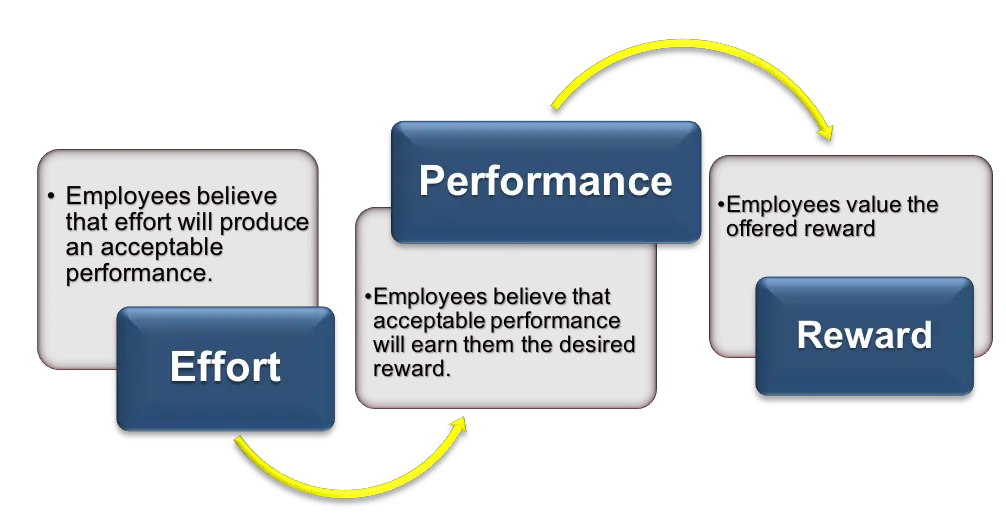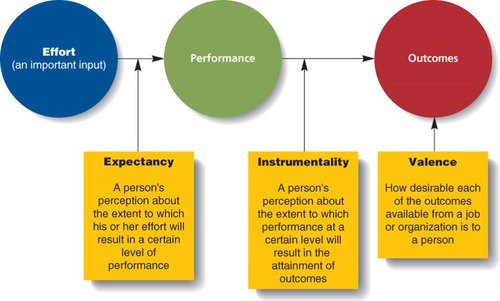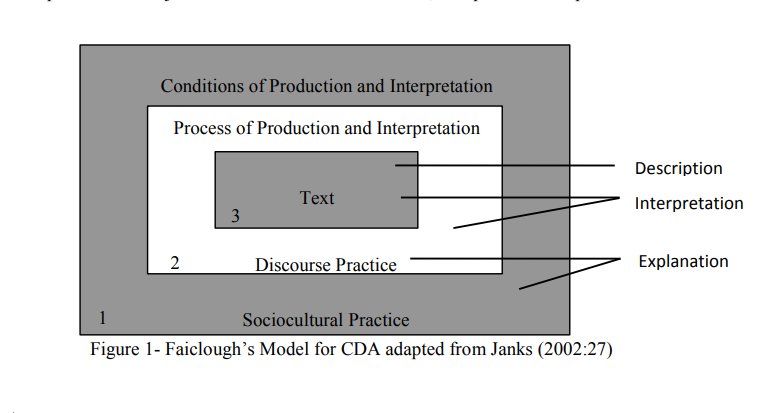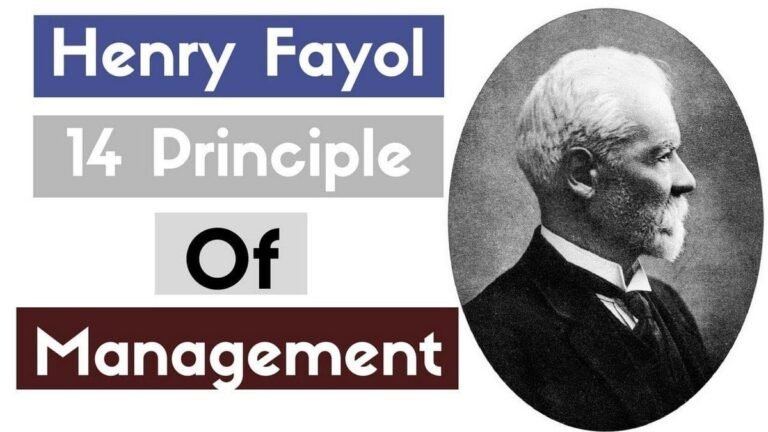Victor Vroom Expectancy Theory 1964 | Valance | Instrumentality | Expectancy
Goals and Objectives of an organization.
- An organization must have goals and objectives to work for them to be successful because if they don’t have goals and objectives, they will drift.
- Organizations are responsible for encouraging employees to contribute to a new organization to the organizational goals and objectives. They have the responsibility to the stakeholders of the business, to the shareholders, to the suppliers, to the customers that their workers who are also stakeholders, their workers, their employees, should be motivated and should empathize with the direction in which the business is moving and in the practices of the company.
- Effective motivation encourages employees, encourages employees to engage with the organizational activities on it also increases productivity. It means there is greater empathy on the part of the workers with the objectives of the business. The workers are more engaged, and there is less labor turnover, this dissatisfaction less absenteeism leading to greater productivity.
Victor Vroom Expectancy Theory 1964
Vroom expectancy theory is a motivation theory and was first proposed by Victor Vroom in 1964 at Yale School of Management.
Vroom expectancy theory is based on the fact that people have different sets of goals and they can be motivated if they have certain expectations.
According to Victor Vroom, motivation can be traced to the decision of how much effort to apply in a specific task situation. The decision choice is based on a two-stage sequence of expectations
First, motivation is affected by an individual’s expectation that a certain level of effort will produce the intended performance goal.
Two, individuals are motivated to the extent that they value the outcomes (i.e., rewards) received.
Vroom Expectancy Theory Motivation and Management
Vroom Expectancy Theory explains motivation and management, how managers encourage and secure a more motivated workforce. The theory looks at how management motivates the workforce.
The concept of Vroom’s expectancy theory explains that motivation is a function of the desired outcome of behavior. This means that if workers are applying themselves to their work, are motivated, and try to achieve the desired outcome.

In the case of motivation, the desired outcome that the workers have in mind motivates them. If an employee or an individual in an organization feels that behaving in a certain way will provide them with rewards that the individual values and seeks, this will motivate them to act accordingly.
💥🎁 New Year & Easter Deals On Amazon !
Don't miss out on the best discounts and top-rated products available right now!
🛒 Shop Now and Save Big Today!*As an Amazon Associate, I earn from qualifying purchases.
The rewards may be more income, a better salary, a particular position, a particular status within the business, or only working on different tasks, and that’s what drives them.
If they feel that they have no chance of fulfilling the expectation, they won’t even try. Still, if they think there is a chance that making a contribution and being motivated in a particular way will lead to their desire, then there will be motivated.
The Causes of Behavior in An Organization
An individual needs motivation, past experiences, and environment determined behavior. These are the main reasons why people join organizations and have certain expectations about their jobs.
Individuals determined their behavior in an organization and not the organization or line manager.
It’s the individuals who determine their behavior within the organization that there are two conscious decisions.
One: How important is it for them to arrive, work and stay within the same organization?
Two: how much to produce, how hard it to work, and the level of performance in the job role?
Suppose the organization has rules and practices on having procedures in place that recognize individuals. In that case, the individuals’ contributions may feel that if they work hard, they will achieve their own objective, receive some small promotion or receive more responsibility, or have a higher salary.
Employees all work in the same organization but have different needs, and the people within the organizations are different.
These different employees need could include;
💥🎁 New Year & Easter Deals On Amazon !
Don't miss out on the best discounts and top-rated products available right now!
🛒 Shop Now and Save Big Today!*As an Amazon Associate, I earn from qualifying purchases.
- Job Security
- Promotion
- Satisfactory rate of pay
- A challenging work environment
Individuals decide on their attitudes and behavior on which type of behavior will lead them to their desired reward. If employees feel that if they apply themselves, work hard, make suggestions, and make recommendations, they will be recognized. They will achieve the reward that they’re after, then that’s the basis for motivation.
The VIE (Valence, Instrumentality, Expectancy) Model
Vroom used a mathematical formula equation to integrate these concepts into a predictive model of motivational force or strength. For our purposes, however, it is sufficient to define and explain the three key concepts within Vroom’s model—expectancy, instrumentality, and valence.
The Valence, Instrumentality, and Expectancy Model was suggested by Victor Vroom in relation to motivational (expectancy) theory at work in the 1964
According to Vroom model, there are basic elements to through model; the first level and second level outcomes, valence, instrumentality, and expectancy.
Expectancy Theory Diagram

The First Level Outcome
The first level outcome is associate with the behavior of an individual who is undertaking the job itself.
This includes the level of performance, the amount of output, the quality of the work put into the job.
The individual is supplying him or herself to performing this task that’s the first level performance.
The Second Level Outcome
The second level is the rewards received through the efforts of the first level. This could be job satisfaction, promotion, pay rise, job security.
💥🎁 New Year & Easter Deals On Amazon !
Don't miss out on the best discounts and top-rated products available right now!
🛒 Shop Now and Save Big Today!*As an Amazon Associate, I earn from qualifying purchases.
The first level outcome is the application to do the job, to undertake the job, to perform well. It’s the quality of the work that’s put in the quality of the output. The second level outcome is the person may be recognized for having a good quality output in producing, and it is the reward.
The Valence in Management
Valance refers to the importance of obtaining a particular second-level outcome. How important is it? It’s a value that the employees place on a goal to receive the promised rewards. How important is it for the workers to make an effort to get the first level outcomes correct? Produce the right quality product to produce? So, how important is it?
It may be rewarded by just job satisfaction, but is that sufficiently rewarding, or do they want a promotion?
Valance is a measure of the strength of determination to receive the second level reward.
A valance comes in two forms.
- Positive Valance
- Negative Valance
Positive valence may include job security and satisfactory pay. Satisfactory pay means that the workers have been recognized good quality output.
The negative valances are factors such as being made redundant, not receiving a promotion sacked from work. The employee didn’t try hard to make a good quality product or meet the required standards or targets.
The valance is the connection between first-level outcomes and second-level outcomes. It’s the strength with which the individual wants to achieve the second level outcomes. The second level outcomes are the job security, the higher pair promotion, etcetera, and the strength with which the individual wants.
Instrumentality in Expectancy Theory
Instrumentality is an analysis of the level of performance, the first level outcomes, which will result in the desired reward (The second level outcomes).
It answers the questions like; Is it sufficient to justify promotion or a higher salary or not? Instrumentality will determine whether that’s the case.
💥🎁 New Year & Easter Deals On Amazon !
Don't miss out on the best discounts and top-rated products available right now!
🛒 Shop Now and Save Big Today!*As an Amazon Associate, I earn from qualifying purchases.
If an employee desires promotion, they will have to acknowledge that better quality performance would be required in achieving this promotion.
A better quality performance is seen as the first level, and the outcome on promotion will therefore be the second level outcome. Therefore, better quality performance will be instrumental in achieving promotion prospects.
Expectancy in Vroom Theory
Expectancy refers to the level of confidence the individual has in achieving a certain task. It’s associated with the relationship between effort on performance.
If the employee feels that the probability of achieving an outcome is zero, they will not even try to put effort into achieving the task; he/she will be demotivated.
There must be a linkage between effort and performance.
However, if the expectancy is higher than the employees, A will put input in more effort in achieving the outcome on receiving the reward. Then they will apply themselves more diligently to the task.
Assumptions of Victor Vroom Expectancy Theory
The assumption here is that they want higher salaries, job security and satisfaction, pay rise job security and promotion. But it’s the strength of that want that determines the effort.
Managers May implement the VIE model.
- The management needs to consider the rewards that the employees perceived as valuable. Management needs to be careful to work these out and understand what it is that motivates the employees.
- Management must create instrumentality by convincing the employees of the potential rewards that may be accomplished.
- The employees must have the capabilities to successfully complete the given task to gain the rewards. So the employees must have the capabilities to look at the effort that’s required. They must expect that they can do the task on achieved the first level outcomes.
The Reasons For Poor Behavior
- Low effort performance expectancy, that is, employees may lack the incentive that extra effort will lead to better performance.
- The Low-performance reward instrumentality relationship that is performance may not lead to the desired rewards that lead to frustration on the part of the workers they feel that they’ve put in a lot of effort and had good first-level outcomes. They’ve had the hit their targets.
Weaknesses of Vroom Expectancy Model
- There is a lack of concreteness and depth. The Vroom Expectancy Model does not discuss what the content of motivation is and what are individual differences. There is a suggestion that there is a link between the first level outcomes and the second level outcomes, but the instrumentality on that linkage is not very clear in the Vroom Model.
- It disregards value. The model is perceived as nothing more than a theory of cognitive hedonism, as it does not discuss individuals’ values. Hedonism is an old philosophical idea that people are motivated by the pursuit of pleasure and happiness. In this case, the individuals make an effort if they’re going to be rewarded.
- The model has not made much of an impact on management thoughts. This Vroom model is seen as complex and difficult to understand by management, and hence it is not widely used but mostly referred to as a theory.
- It lacks practical support and not enough research consulted.
Summary; Vroom Expectancy Theory
Expectancy is the level of confidence the individual has in achieving a certain task, and if the individual thinks they can achieve it, they will make an effort and vice versa
Instrumentality is the analysis of performance. The first level outcome, for example, better work, which will result in the desired reward (the second level outcome).
Thus, are the first level outcomes being instrumental in bringing about the second-level outcomes.
💥🎁 New Year & Easter Deals On Amazon !
Don't miss out on the best discounts and top-rated products available right now!
🛒 Shop Now and Save Big Today!*As an Amazon Associate, I earn from qualifying purchases.
Valance refers to the importance of obtaining particular several second-level outcomes. It’s a value that the employees place on a goal to receive the promised rewards.



